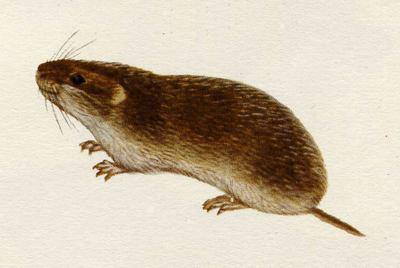Pests
Microtus (Stenocranius) gregalis (Pallas, 1778) - Narrow-skulled vole (Meadow mouse).
Systematic position.
The class Mammalia, order Rodentia, family Cricetidae, subfamily Microtinae, genus Microtus, subgenus Stenocranius. The species contains from 10 to 14 subspecies (based on data from different sources).Biological group.
Rodent pests.Morphology and biology.
Body length of the larger of the species (tundra) reaches up to 140 mm, with tail length up to 43 mm (21.5-33.3% of body length). Body length of the smaller of the species (steppe) reaches up to 115 mm, with the tail length up to 24 mm (24-28% of body length). Eyes are more closed than those of other gray voles. On the back foot there are 6 calluses, instead of 5 as in other gray voles. The coloration of the body dorsum varies from brownish-gray with light endings of guard hairs to reddish-ochre, sometimes light; body ventrum from dark grey to yellowish-ochre. Blurred black stripe is visible (especially clear among the juveniles) on occipital and fore part of back. Tail is distinctly bicolorate. Diploid set of chromosomes; 36. The species inhabits open landscapes of plains and mountains from tundra and forest-tundra to Alpine meadows. The habitats are varied, but the vole prefers damper sites and fields of perennial grasses on cultivated lands. Lives in colonies, settles composite holes and leads semi-underground mode of life.Distribution.
The present area contains some isolated loci in northern (tundra) and southern (steppe and mountain) parts of the former distribution area. From the White Sea in the west to Kolyma river in the east, to Northern and Central Mongolia and Northwest China in the south. In the former USSR-Northern, Central and Eastern Kazakhstan; a western part of the Ural region (Republic of Bashkortostan, Perm, Sverdlovsk, Chelyabinsk, Kurgan Regions); western Siberia (Omsk, Novosibirsk, Kemerovo Regions, Altai Territory); eastern Siberia (Krasnoyarsk Territory, Irkutsk and Chita Regions, Republic of Tyva and Republic of Khakasiya, Buryat autonomous district); Central and Southern Yakutiya.Ecology.
This species is characterized by high agility and activity, especially during evening and night hours. In places of settlement a well developed grid of paths is characteristic of this species; the paths are used for safe foraging under herbage. Underground passages leading to places of feeding are made after the end of a vegetation period. The vole feeds on sappy herbaceous green parts, grains, seeds, bulbs and rhizomes of both cultivated and wild plants. This species prepares large reserves for winter. Reproduction takes place during an entire warm season, starting in the tundra at the end of winter under snow; usually 3-4 broods in the northern part of area and 4-5 in the southern part. This species produces 3 to 12 young voles in a brood, 7-9 on the average. Fast development (especially in the northern animals) and early puberty are characteristic of this species. The population density, similar to populations of other gray voles, is subject to strong fluctuations and depends mainly on food supply and favorable weather conditions.Economic significance.
Serious pest of grain crops during the years of mass outbreaks. Density of holes reaches 15 thousand and more per hectare in some fields. Capable of descending overall phytomass in Alpine pastures. In some places 50-75% of grass fodder crops are destroyed and, as a result, large spots are completely devoid of green plants and are covered with heaps of dirt surrounding holes. The expansion of areas with perennial grasses can favor broader invading of agricultural lands, especially in Krasnoyarsk Territory and Northern Kazakhstan in regions of wind erosion, where deep plowing with soil overturning is not carried out on fields. This is generally an effective agronomical method for pest control. The species is dangerous in an epidemiological sense as a vector of tularemia and other transmissible diseases. It is also prey to the fur-bearing animals in northern regions of area.Reference citations:
Gromov I.M., Polyakov I.Ya. 1977. Voles (Microtinae). In: Strelkov A.A., ed. Fauna of the USSR. Mammals. V. 3, Issue 8. Leningrad: Nauka. 504 pp. (In Russian)Prokopyev N.P., Vinokurov V.N. 1986. Narrow-skulled vole in Central Yakutia. Yakutsk: Yakutskii filial SO AN SSSR. 143 pp.
Rapoport L.P. 1955. Stuffs on an ecology Narrow-skulled vole in Central Tien-Shan. In: Trudy Instituta zoologii i parazitologii AN Kirgizskoi SSR. Frunze. V. 3: 43-51.
Sokolov I.I., ed. 1963. Mammalian fauna of the USSR. Part 1. Leningrad: Izd. AN SSSR. 638 pp. (In Russian)
Zymin R.P. 1953. Narrow-skulled vole on high-mountainous pastures of Tien-Shan. In: Geograficheskie issledovaniya v Tsentralnom Tyan-Shane. Moscow: Izd. AN SSSR. 160-186 pp.


